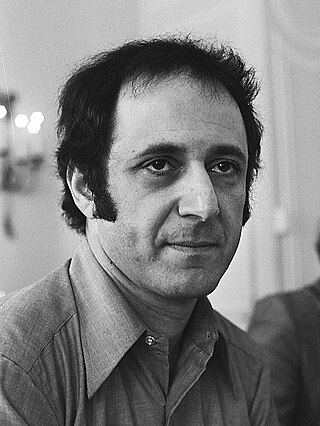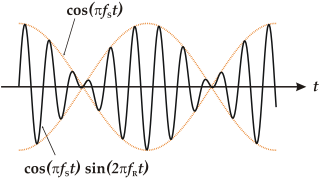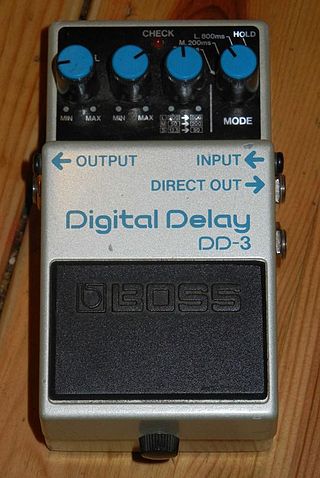
An effects unit, effects processor, or effects pedal is an electronic device that alters the sound of a musical instrument or other audio source through audio signal processing.

Stephen Michael Reich is an American composer who is known for his contribution to the development of minimal music in the mid to late 1960s. Reich's work is marked by its use of repetitive figures, slow harmonic rhythm, and canons. Reich describes this concept in his essay, "Music as a Gradual Process", by stating, "I am interested in perceptible processes. I want to be able to hear the process happening throughout the sounding music." For example, his early works experiment with phase shifting, in which one or more repeated phrases plays slower or faster than the others, causing it to go "out of phase." This creates new musical patterns in a perceptible flow.
Piano Phase is a minimalist composition by American composer Steve Reich, written in 1967 for two pianos. It is one of his first attempts at applying his "phasing" technique, which he had previously used in the tape pieces It's Gonna Rain (1965) and Come Out (1966), to live performance.

In C is a musical piece composed by Terry Riley in 1964 for an indefinite number of performers. He suggests "a group of about 35 is desired if possible but smaller or larger groups will work". A series of short melodic fragments that can be repeated at the discretion of musicians, In C is often cited as the first minimalist composition to make a significant impact on the public consciousness.

In music, tape loops are loops of magnetic tape used to create repetitive, rhythmic musical patterns or dense layers of sound when played on a tape recorder. Originating in the 1940s with the work of Pierre Schaeffer, they were used among contemporary composers of 1950s and 1960s, such as Éliane Radigue, Steve Reich, Terry Riley, and Karlheinz Stockhausen, who used them to create phase patterns, rhythms, textures, and timbres. Popular music authors of 1960s and 1970s, particularly in psychedelic, progressive and ambient genres, used tape loops to accompany their music with innovative sound effects. In the 1980s, analog audio and tape loops with it gave way to digital audio and application of computers to generate and process sound.

Process music is music that arises from a process. It may make that process audible to the listener, or the process may be concealed.
Violin Phase is a musical work written by minimalist composer Steve Reich in October 1967.
Minimal music is a form of art music or other compositional practice that employs limited or minimal musical materials. Prominent features of minimalist music include repetitive patterns or pulses, steady drones, consonant harmony, and reiteration of musical phrases or smaller units. It may include features such as phase shifting, resulting in what is termed phase music, or process techniques that follow strict rules, usually described as process music. The approach is marked by a non-narrative, non-teleological, and non-representational approach, and calls attention to the activity of listening by focusing on the internal processes of the music.

Different Trains is a three-movement piece for string quartet and tape written by Steve Reich in 1988.

Six Pianos is a minimalist piece for six pianos by the American composer Steve Reich. It was completed in March 1973. He also composed a variation for six marimbas, called Six Marimbas, in 1986. The world première performance of Six Pianos was in May 1973 at the John Weber Gallery in New York City. The European première took place in January the next year in Stuttgart, Germany.

In acoustics, a beat is an interference pattern between two sounds of slightly different frequencies, perceived as a periodic variation in volume whose rate is the difference of the two frequencies.
It's Gonna Rain is a tape composition written by Steve Reich in 1965. It lasts about 18 minutes. It was Reich's first major work and is considered a landmark in minimalism and process music.
Chorus is an audio effect that occurs when individual sounds with approximately the same time, and very similar pitches, converge. While similar sounds coming from multiple sources can occur naturally, as in the case of a choir or string orchestra, it can also be simulated using an electronic effects unit or signal processing device.
Come Out is a 1966 piece by American composer Steve Reich. Reich was asked to edit down tape footage into a form of collage for a benefit for the Harlem Six and Come Out was a byproduct of the collage's production. The Harlem Six were six black youths arrested for a murder of Margit Sugar, a Hungarian refugee, in Harlem in the weeks following the Little Fruit Stand Riot of 1964. Only one of the six was responsible while the lead witness is generally considered the actual perpetrator. Truman Nelson, a civil rights activist and New Yorker who had asked Reich to compose a sound collage that was separate from Come Out, gave him a collection of tapes with recorded voices to use as source material. Nelson agreed to give Reich creative freedom with the tapes that he presented him for the sound collage. Come Out was a loop of four seconds from the more than 70 hours of tapes Nelson presented to Reich.

Delay is an audio signal processing technique that records an input signal to a storage medium and then plays it back after a period of time. When the delayed playback is mixed with the live audio, it creates an echo-like effect, whereby the original audio is heard followed by the delayed audio. The delayed signal may be played back multiple times, or fed back into the recording, to create the sound of a repeating, decaying echo.

Clapping Music is a minimalist piece written by Steve Reich in 1972. It is written for two performers and is performed entirely by clapping.

Drumming is a piece by minimalist composer Steve Reich, dating from 1970–1971. Reich began composition of the work after a short visit to Ghana and observing music and musical ensembles there, especially under the Anlo Ewe master drummer Gideon Alorwoyie. His visit was cut short after contracting malaria. Classical music critic K. Robert Schwarz describes the work as "minimalism's first masterpiece".
The term polytempo or polytempic is used to describe music in which two or more tempi occur simultaneously.
Reed Phase, also called Three Reeds, is an early work by the American minimalist composer Steve Reich. It was written originally in 1966 for soprano saxophone and two soprano saxophones recorded on magnetic tape, titled at that time Saxophone Phase, and was later published in two versions: one for any reed instrument and tape, the other for three reed instruments of exactly the same kind. It was Reich's first attempt at applying his "phasing" technique, which he had previously used in the tape pieces It's Gonna Rain (1965) and Come Out (1966), to live performance.
New York Counterpoint for amplified clarinet and tape, or 9 clarinets and 3 bass clarinets, is a 1985 minimalist composition written by American composer Steve Reich. The piece, intended to capture the throbbing vibrancy of Manhattan, is notable for its ability to imitate electronic sounds through acoustic instrumentation.



 and the other parts play the same rhythm faster by 101%. 102%, 103%, ..., 115%. Played on harmonics: the first eight parts play the first eight harmonics, and the second eight parts play the same harmonics transposed down an octave.
and the other parts play the same rhythm faster by 101%. 102%, 103%, ..., 115%. Played on harmonics: the first eight parts play the first eight harmonics, and the second eight parts play the same harmonics transposed down an octave.









